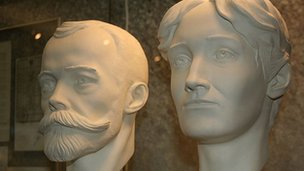Grandduchess24
Serene Highness
- Joined
- Mar 17, 2011
- Messages
- 1,313
- City
- Cambridge
- Country
- United States
They should've at least been exiled but not murdered.July 17.1918.is a memorial day for me.
Some of the royal family (such as the other Grand Dukes) could have escaped if they were savvy enough to know that the end was coming but I doubt many of them thought their lives would be lost
Nicholas was a fool and a terrible Tsar
The 'Windsors' were Saxe-Coburg and Gotha's , not Hanovers. A cabinet member of George V supposedly came up with the name on July 17th, 1917. If George would have stood up to his wife, Queen Mary, who told him in no uncertain terms not to bring 'Nicky' and the rest of the family to England, history may have been kinder to the Romanovs. But, then again, maybe not. Maybe there would still be a monarchy in Russia and GD Maria would not be THE Pretender to the Throne now.
No, they wouldn't. You were correct that the name of the Royal House of Britain before the Windsors was Saxe-Coburg and Gotha; I just got into unnecessary technicalities. My apologies for that; genealogy is my hobby and I tend to get carried away.Sorry about the family name, Artemisia. I never heard of Saxe-Coburg Saalfeld. I only assumed that their old family name was the OTHER Saxe-Coburg area. So, if the name Windsor had not come into existence as a family name, and not just a castle, do you think they would be still known as Saxe-Coburg Saalfeld?
My dear VM: I'm ashamed to say this, but at the moment, I don't remember where I read that about Queen Mary. I know it was either in one of my 'Majesty' magazines or perhaps, a book on the Romanovs. I got the feeling that Q. Mary didn't mind 'Nicky', but couldn't stand Alix, ]

Yes, it was Alix who was the main problem in everyone's eyes. There was so much anti-German fervor that the Windsors changed their dynastic name (to Windsor of course). Either way, it was a cowardly act.
I hope that the Windsors are never in need of refuge at the hands of any other royal family, I can tell you that much. There is a thing such as karma and I hope taht they don't need refuge, or the royals of the world might instead ask "Why, when you didn't help the Romanovs?"
My dear VM: I'm ashamed to say this, but at the moment, I don't remember where I read that about Queen Mary. I know it was either in one of my 'Majesty' magazines or perhaps, a book on the Romanovs. I got the feeling that Q. Mary didn't mind 'Nicky', but couldn't stand Alix, just like her husband. I will search my mags and books to see where I saw that. Wherever I saw it, it said when K.George discussed it with his wife, she simply said 'no' to the idea of the Romanovs moving in. In 'The Last Days of the Romanovs', when Mary and George did find out 3 or 4 days after the R's. had been executed,they were very sad, and kept George's aunt Helena waiting more than an hour for lunch while they mourned 'Nicky's' passing. At that point, Queen Mary referred to the Bolsheviks as 'those brutes who killed Nicky'. I don't recall if she said anything about Alexandra and the children.
How silly. 1) none of the other royal families, not even their cousins the Danes, went to their rescue either. 2) We're British and its the 21st century so we are unlikely to go in for Bolshevik type revolutions unless we succumb to some mass national drug induced hysteria.



 Memorial to Imperial Children 'Vandalized'
Memorial to Imperial Children 'Vandalized' Investigative committee declares tsar family remains ‘authentic’
Investigative committee declares tsar family remains ‘authentic’ Russian government asked to rebury remains of 2 Romanov children
Russian government asked to rebury remains of 2 Romanov children Romanov grand duchess to be buried in St. Petersburg on June 3
Romanov grand duchess to be buried in St. Petersburg on June 3  Russian tsarist Romanov family seeks exoneration
Russian tsarist Romanov family seeks exoneration
